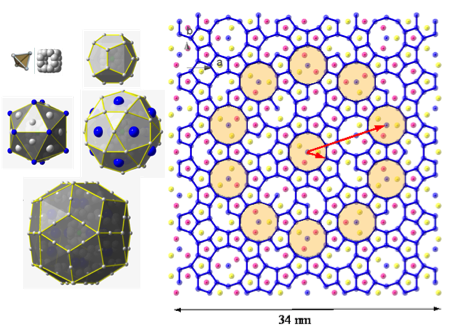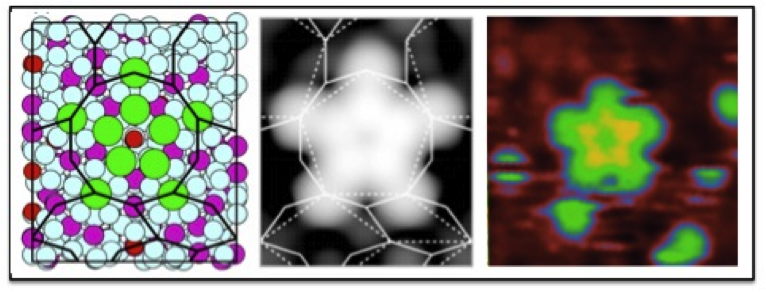Complexity
Basics of periodic and aperiodic order in metallic alloys and compounds
Understanding the structure and the physical properties of complex metallic alloys (CMA) has been one of the main targets within the network both for bulk and surfaces studies. This is a particularly difficult task since the periodic character and the associated tools such as the Bloch theorem, are rather weak or even do not exist in quasicrystals. The atomic structure of CMAs is often described as a packing of atomic clusters together with some chemical or positional disorder. However, the relationships between the atomic structure, the description in term of clusters, the disorder and the associated physical properties still remain an open question. This is a crucial point for any further ‘design' of materials having targeted physical properties.
To tackle this problem studies have been carried out on a series of materials with increasing complexity, where the structure (bulk and surfaces) and physical properties (electronic structure, electronic and heat transport properties, magnetism) have been determined. Substantial progress has been achieved thanks to (i) a better understanding of the atomic structure of the bulk and the surfaces even of the most complex CMA’s such as quasicrystals; (ii) the possibility in some cases to achieve ab-initio or ab-initio based simulations on large systems. For the first time in such complex systems, this has allowed having a joint and combined theoretical and experimental research activity. The synergy between the European Integrated Center partners has been a key for the success [1,4].
Three long term projects are running within the RAD:
(i) Structure-physical properties relationship. This is carried out on phases with increasing complexity [1-3].
(ii) Mechanisms stabilizing long range aperiodic and complex periodic order. This is a fascinating question which can now be tackled combining experimental results and simulation. Simple theoretical models are also being developed.
(iii) Evolution of the surface properties with structural complexity: this is a key for the understanding of surface properties such as catalysis. Combined experimental and simulation work will be carried out [4-6].

Figure 1: Left: Illustration of the atomic structure of the Cd-Yb quasicrystal. Right: Oscillating pair potential used in the Zn-Sc system for simulations of the lattice dynamics of quasicrystals [1].

Figure 2: (Left) the largest circles indicate the position of Pb adatoms on the five-fold Al-Pd-Mn surface. (Middle) Corresponding simulated STM image. (Right) Pb pentagonal islands observed using STM at submonolayer regime [6].
1. M. de Boissieu, S. Francoual, M. Mihalkovic, K. Shibata, A.Q.R. Baron, Y. Sidis, T. Ishimasa, D. Wu, T. Lograsso, L.P. Regnault, F. Gähler, S. Tsutsui, B. Hennion, P. Bastie, T.J. Sato, H. Takakura, R. Currat, and A.P. Tsai. Lattice dynamics of the Zn–Mg–Sc icosahedral quasicrystal and its Zn–Sc periodic 1/1 approximant. Nature Materials, 6, 2007, 977-984;H. Takakura, C.P. Gómez, A. Yamamoto, M. de Boissieu and A.P. Tsai, Nature Materials 6, 58-63 (2007)
2. M. Andersson, M. de Boissieu, S. Brühne, C. Drescher, W. Assmus, S. Ohahshi, A. P. Tsai, M. Mihalkovič, M. Krajčí, and Ö. Rapp, Phys. Rev. B 82, 024202 (2010).
3. H. Euchner, M. Mihalkoviˇc, F. Gaehler, M. R. Johnson, H. Schober, S. Rols, E. Suard, A. Bosak, S. Ohhashi, A.-P. Tsai, S. Lidin, C. Pay Gomez, J. Custers, S. Paschen, and M. de Boissieu, Phys. Rev B. 83, 144202, (2011)
4. R. Addou, E. Gaudry, T. Deniozou, M. Heggen, M, Feuerbacher, P. Gille, Yu. Grin, R. Widmer, O. Groning, V. Fournee, J.-M. Dubois, J. Ledieu. Structure investigation of the (100) surface of the orthorhombic Al13Co4 crystal. Phys. Rev. B 80, 2009, 014203.
5.T. Duguet, B. Ünal, J. Ledieu, J.-M. Dubois, V. Fournée, and P. A. Thiel, Phys. Rev. Lett. 106, 076101 (2011).
6. J. Ledieu, M. Krajci, J. Hafner, L. Leung, L.H. Wearing, R. McGrath, T.A. Lograsso, D. Wu, and V. Fournée, Nucleation of Pb starfish clusters on the five-fold Al-Pd-Mn quasicrystal surface. Phys. Rev. B, 2009. 79 165430-1-10
RAD leader: Marek Mihalkovič
